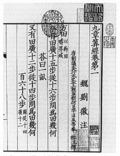Equation
A mathematical equation is a mathematical object containing two or more expressions connected by equals signs (=).[1][2][3][4] The equals sign says that all of the expressions describe the same mathematical object.
An equation should not be confused with an expression. An expression is one piece of an equation, and does not have the equals sign. Equations are the most common type of formula.
There are two kinds of mathematical equations:
- The kind of equation that is either true or false; these are also called identities. For example:
- [math]\displaystyle{ 2\cdot(x+4)=2x+8\rightarrow\text{true} }[/math]
- The kind of equation that is only true for certain values of the variable(s). The equation is only true if the variable(s) have that value. For example:
- [math]\displaystyle{ 2\cdot x=8\rightarrow x=4 }[/math]
The second kind is often used to solve problems in which finding the value of some variables is involved. For example, if
- [math]\displaystyle{ 2x=8 }[/math], [math]\displaystyle{ x=\frac82=4 }[/math]
Types of equations
Equations can be classified by the types of operations and quantities involved. For example:
- An algebraic equation is an equation in which both sides are polynomials. These are further classified by degree:
- Linear equation for degree one
- Quadratic equation for degree two
- Cubic equation for degree three
- Quartic equation for degree four
- Quintic equation for degree five
- A Diophantine equation is an equation where the unknowns are required to be integers
- A differential equation is a functional equation involving derivatives of the unknown functions, which include:
Equation Media
The first use of an equals sign, equivalent to 14x + 15 = 71 in modern notation. From The Whetstone of Witte by Robert Recorde of Wales (1557).
The solutions –1 and 2 of the polynomial equation x2 – x + 2 = 0 are the points where the graph of the quadratic function y = x2 – x + 2 cuts the x-axis.
The Nine Chapters on the Mathematical Art is an anonymous 2nd-century Chinese book proposing a method of resolution for linear equations.
The blue and red line is the set of all points (x,y) such that x+y=5 and -x+2y=4, respectively. Their intersection point, (2,3), satisfies both equations.
A strange attractor, which arises when solving a certain differential equation
Related pages
References
- ↑ "Compendium of Mathematical Symbols". Math Vault. 2020-03-01. Retrieved 2020-09-01.
- ↑ "Equations and Formulas". www.mathisfun.com. Retrieved 2020-09-01.
- ↑ "A statement of equality between two expressions. Equations are of two types, identities and conditional equations (or usually simply "equations")". « Equation », in Mathematics Dictionary, Glenn James et Robert C. James (éd.), Van Nostrand, 1968, 3 ed. 1st ed. 1948, p. 131.
- ↑ Une équation est une égalité entre deux expressions mathématiques, donc une formule de la forme A = B, où les deux membres A et B de l'équation sont des expressions où figurent une ou plusieurs variables, représentées par des lettres. ÉQUATION, mathématique - Encyclopædia Universalis





